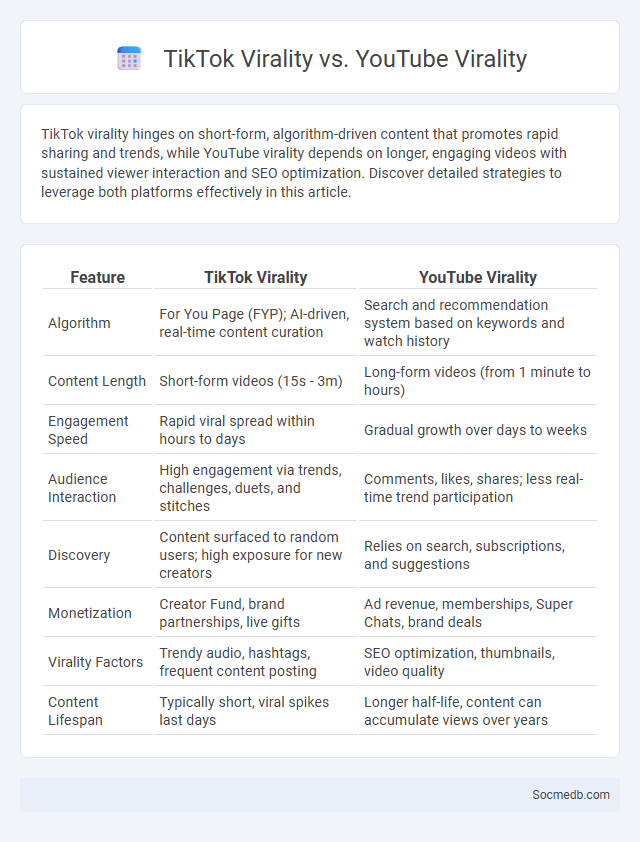
Photo illustration: TikTok Virality vs YouTube Virality
TikTok virality hinges on short-form, algorithm-driven content that promotes rapid sharing and trends, while YouTube virality depends on longer, engaging videos with sustained viewer interaction and SEO optimization. Discover detailed strategies to leverage both platforms effectively in this article.
Table of Comparison
| Feature | TikTok Virality | YouTube Virality |
|---|---|---|
| Algorithm | For You Page (FYP); AI-driven, real-time content curation | Search and recommendation system based on keywords and watch history |
| Content Length | Short-form videos (15s - 3m) | Long-form videos (from 1 minute to hours) |
| Engagement Speed | Rapid viral spread within hours to days | Gradual growth over days to weeks |
| Audience Interaction | High engagement via trends, challenges, duets, and stitches | Comments, likes, shares; less real-time trend participation |
| Discovery | Content surfaced to random users; high exposure for new creators | Relies on search, subscriptions, and suggestions |
| Monetization | Creator Fund, brand partnerships, live gifts | Ad revenue, memberships, Super Chats, brand deals |
| Virality Factors | Trendy audio, hashtags, frequent content posting | SEO optimization, thumbnails, video quality |
| Content Lifespan | Typically short, viral spikes last days | Longer half-life, content can accumulate views over years |
Understanding Virality: TikTok vs YouTube vs Viral Loop
Understanding virality involves analyzing user engagement patterns on platforms like TikTok, YouTube, and the Viral Loop concept. TikTok's algorithm prioritizes short, engaging videos with trending sounds, driving rapid content spread among diverse audiences. YouTube emphasizes longer-form content with SEO optimization to sustain viewer retention, while the Viral Loop strategy relies on users sharing content to organically amplify reach across networks.
Key Algorithms: How TikTok and YouTube Drive Virality
TikTok's algorithm prioritizes short-form video content by analyzing user interactions, video information, and device settings to deliver highly personalized For You pages that maximize content discovery and engagement. YouTube's recommendation system leverages viewer watch history, video metadata, and engagement metrics to promote videos with high retention rates and viewer satisfaction, driving sustained virality. Both platforms employ machine learning to continuously refine content delivery, making their algorithms critical in shaping viral content trends globally.
Content Format Differences Impacting Virality
Short-form videos dominate virality on platforms like TikTok and Instagram Reels due to their engaging, quick consumption format that caters to users' decreasing attention spans. In contrast, longer, in-depth articles and podcasts perform better on platforms like LinkedIn and Spotify, where audiences seek detailed information and storytelling. Understanding these content format differences can help you tailor your social media strategy to maximize shareability and audience engagement.
Audience Behavior on TikTok and YouTube
Understanding audience behavior on TikTok and YouTube reveals distinct engagement patterns driven by content type and platform algorithms. TikTok users favor short, visually stimulating videos with trending audio, promoting quick, repetitive views that boost virality. Your marketing strategy should leverage YouTube's longer format appeal, where viewers seek in-depth tutorials, reviews, and entertainment, fostering loyal communities through consistent, value-rich uploads.
Viral Loop Explained: Mechanisms and Examples
Viral loop is a powerful growth mechanism in social media where users invite others, creating a self-perpetuating cycle of engagement and expansion. Key components include user incentives, seamless sharing features, and compelling content that encourages participation and organic spread. Examples such as Facebook's friend invites, TikTok challenges, and Dropbox's referral program showcase how viral loops drive exponential user acquisition and platform success.
TikTok Virality: Features Fueling Explosive Growth
TikTok's viral growth stems from its AI-driven For You Page, which delivers hyper-personalized content that maximizes user engagement and retention. The platform's short-form video format encourages creative expression and rapid content consumption, fueling widespread sharing and repeated interactions. Interactive features like duets and challenges amplify community participation, driving exponential reach and organic virality.
YouTube Virality: Longevity and Shareability
YouTube virality hinges on content longevity and shareability, driving sustained viewer engagement beyond initial spikes. Optimizing titles, thumbnails, and tags boosts discoverability, while creating emotionally resonant or informative videos encourages shares across social platforms. You can amplify your video's reach by fostering audience interaction through comments, likes, and community posts, ensuring prolonged visibility and viral potential.
Triggering the Viral Loop: Strategies That Work
Triggering the viral loop involves creating engaging content that encourages users to share organically, amplifying reach exponentially. Personalized calls-to-action and seamless sharing features boost your content's spread across social networks, driving continuous user participation. Understanding platform-specific algorithms and leveraging influencer collaborations enhance the viral potential of your campaigns.
Comparing Engagement Metrics Across Platforms
Analyzing engagement metrics such as likes, shares, comments, and click-through rates reveals significant variations across social media platforms like Instagram, Facebook, Twitter, and LinkedIn. Instagram typically boasts higher interaction rates per post due to its visual-centric design, while LinkedIn excels in generating meaningful professional engagement. Understanding these platform-specific metrics enables you to tailor your content strategy for maximum impact and improved audience connection.
Choosing the Right Platform for Maximum Virality
Selecting the right social media platform is crucial for maximizing your content's virality by targeting the specific audience where they are most engaged. Platforms like TikTok and Instagram excel for visual, short-form content, while Twitter and LinkedIn cater to more niche or professional audiences. Understanding your audience's preferences and behavior ensures your content gains optimal reach and shares.
 socmedb.com
socmedb.com